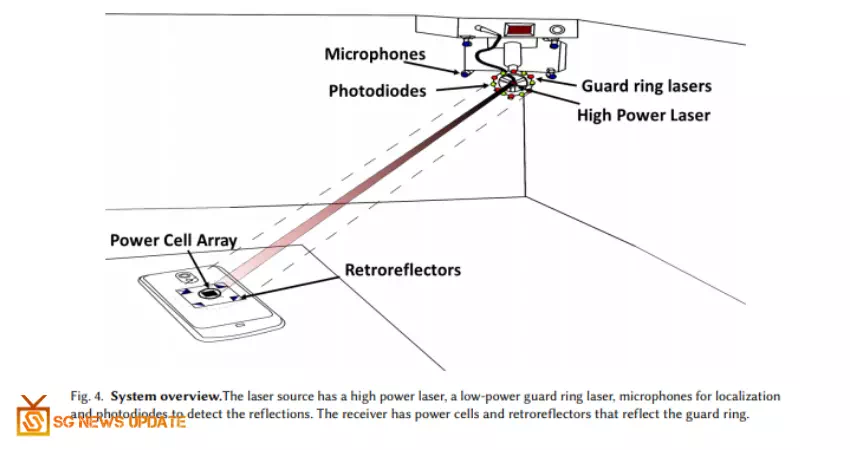
Researchers have sorted out an approach to impeccably radiate energy over any room, because of a science fiction like gadget they call an "anti-laser."
The thought is basic: Just like a laser discharges light particles, or photons, consistently in a perfect and systematic line, an anti-laser sucks up photons in a steady progression in reverse direction. Scientists have since quite a while ago conjectured that a gadget like this may make wires and charging links a relic of days gone by, permitting individuals to radiate energy imperceptibly over a space to a PC or phone and power it without connecting it. In any case, however essential anti-lasers have been tried previously, this present reality isn't as perfect and organized as a laser pointed at a fixed recipient in a lab. Electronics move around, objects disrupt the general flow, barriers reflect energy in unforeseen ways. The new anti-laser showed in this analysis represents all that, and it gets spread energy radiated around a space in an unpredictable arrangement — as yet accepting 99.996% of the sent power.
The conventional term for the technique they utilized is "Coherent Perfect Absorption" (CPA). CPA utilizes one machine to send power over the room, and another (the "anti-laser") to draw it back up. Past CPA analyzes, the analysts wrote in a paper distributed Nov. 17 in the journal Nature Communications, were energizing however a crucial impediment had: the course of time. The examinations worked distinctly in circumstances where time could stream as effectively in reverse as forward, which seldom exist in our everyday lives.
The most straightforward model of an anti-laser arrangement, including a laser pointer shooting photons consistently into a receiver that eats them up, would look essentially a similar whether you played a tape of its activity forward or in reverse: Photon jumps out of one gadget, traversed space and enters the other gadget. Arrangements like this, in material science terms, are said to have "time reversal symmetry." Time-reversal symmetry just springs up in frameworks absent a lot of entropy, or the inborn inclination of frameworks to slide into jumble.
As of not long ago, even the most mind boggling CPA tests have had time inversion symmetry. Some were more perplexing than the laser pointer focused on a collector. In any case, even convoluted ventures have that symmetry on the off chance that they're set up with the end goal that the cycle can be reversed.
(Here's a case of how a confounded occasion can be time inversion symmetric: Imagine a videotape of a specialist getting Lego pieces from a conveniently coordinated case and utilizing them to construct a model Eiffel Tower. The outcome would look muddled, yet the tape would record where each piece had gone, so playing the tape in reverse would simply show the specialist dismantling the pieces and coordinating them once more.)
Yet, for this new work, the specialists utilized magnetic fields to jostle the photons so powerfully that time inversion symmetry was lost. The way toward moving power — shooting the photons — resembled mixing soup: It doesn't work in reverse. (Envision attempting to un-mix soup.) But the gadget actually got the power.
This "demonstrates that the idea of CPA goes a long ways past its underlying origination as a 'time reversed laser,'" the analysts wrote in their paper, recommending it may one day have functional applications in reality. That is on the grounds that this present reality isn't as slick as a time reversible research center experiment. It's chaotic and eccentric, and never time-reversible over the long haul. For CPA to work in those difficult conditions, it must have the option to manage it.
The analysts pulled off this non-time reversed CPA in two experimental arrangements, both utilizing microwave energy. The first was a “labyrinth" of wires that photons needed to explore to arrive at a collector. The second was a little, unpredictable "brass cavity" with a receiver in the center, which the photons came to in the wake of dissipating and crossing the open space in the cavity.
To pull this off, the specialists radiated microwaves of various properties, and tried which mix of frequencies, amplitudes and stages (three highlights of any electromagnetic wave) was well on the way to arrive on the recipient and get ingested — even subsequent to going through the attractive fields and the labyrinth or unpredictable open space. For each situation, they decided an ideal "tuning" of the microwave producer that made the majority of the microwaves get retained (99.999% in the labyrinth, 99.996% in the open space). In true applications (like your lounge), the emitter would test and retest the various frequencies, amplitudes and stages to move photons to its collector.
Any such true uses are as yet far off. In any case, this examination shows they're at any rate conceivable, the analysts composed.
Coming Soon...!
Comments (0)